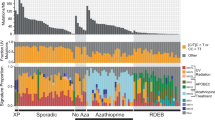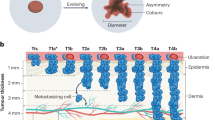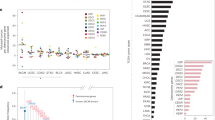Summary
In melanoma, the relationship between sun exposure and the origin of mutations in either the N-ras oncogene or the p53 tumour-suppressor gene is not as clear as in other types of skin cancer. We have previously shown that mutations in the N-ras gene occur more frequently in melanomas originating from sun-exposed body sites, indicating that these mutations are UV induced. To investigate whether sun exposure also affects p53 in melanoma, we analysed 81 melanoma specimens for mutations in the p53 gene. The mutation frequency is higher than thus far reported: 17 specimens (21%) harbour one or more p53 mutations. Strikingly, 17 out of 22 mutations in p53 are of the C:G to T:A or CC:GG to TT:AA transitional type, strongly suggesting an aetiology involving UV exposure. Interestingly, the p53 mutation frequency in metastases was much lower than in primary tumours. In the case of metastases, a role for sun exposure was indicated by the finding that the mutations are present exclusively in skin metastases and not in internal metastases. Together with a relatively frequent occurrence of silent third-base pair mutations in primary melanomas, this indicates that the p53 mutations, at least in these tumours, have not contributed to melanomagenesis and may have originated after establishment of the primary tumour.
Similar content being viewed by others
Article PDF
Change history
16 November 2011
This paper was modified 12 months after initial publication to switch to Creative Commons licence terms, as noted at publication
References
Akslen, L. A., Monstad, S. E., Larsen, B., Straume, O. & Ogreid, D. (1998). Frequent mutations of the p53 gene in cutaneous melanoma of the nodular type. Int J Cancer 79: 91–95.
Albino, A. P., Vidal, M. J., McNutt, N. S., Shea, C. R., Prieto, V. G., Nanus, D. M., Palmer, J. M. & Hayward, N. K. (1994). Mutation and expression of the p53 gene in human malignant melanoma. Melanoma Res 4: 35–45.
Brash, D. E., Rudolph, J. A., Simon, J. A., Lin, A., McKenna, G. J., Baden, H. P., Halperin, A. J. & Ponten, J. (1991). A role for sunlight in skin cancer: UV-induced p53 mutations in squamous cell carcinoma. Proc Natl Acad Sci USA 88: 10124–10128.
Campbell, C., Quinn, A. G., Ro, Y. S., Angus, B. & Rees, J. L. (1993). P53 mutations are common and early events that precede tumor invasion in squamous cell neoplasia of the skin. J Invest Dermatol 100: 746–748.
Castresana, J. S., Rubio, M. P., Vazquez, J. J., Idoate, M., Sober, A. J., Seizinger, B. R. & Barnhill, R. L. (1993). Lack of allelic deletion and point mutation as mechanisms of p53 activation in human malignant melanoma. Int J Cancer 55: 562–565.
Florenes, V. A., Oyjord, T., Holm, R., Skrede, M., Borresen, A. L., Nesland, J. M. & Fodstad, O. (1994). Tp53 allele loss, mutations and expression in malignant melanoma. Br J Cancer 69: 253–259.
Greenblatt, M. S., Bennett, W. P., Hollstein, M. & Harris, C. C. (1994). Mutations in the p53 tumor suppressor gene: clues to cancer etiology and molecular pathogenesis. Cancer Res 54: 4855–4878.
Hainaut, P., Soussi, T., Shomer, B., Hollstein, M., Greenblatt, M., Hovig, E., Harris, C. C. & Montesano, R. (1997). Database of p53 gene somatic mutations in human tumors and cell lines: updated compilation and future prospects. Nucleic Acids Res 25: 151–157.
Hartmann, A., Blaszyk, H., Cunningham, J. S., McGovern, R., Schroeder, J. S., Helander, S. D., Pittelkow, M. R., Sommer, S. S. & Kovach, J. S. (1996). Overexpression and mutation of p53 in metastatic malignant melanomas. Int J Cancer 67: 313–317.
Hollstein, M., Rice, K., Greenblatt, M. S., Soussi, T., Fuchs, R., Sorlie, T., Hovig, E., Smith-Sorensen, B., Montesano, R. & Harris, C. C. (1994). Database of p53 gene somatic mutations in human tumors and cell lines. Nucleic Acids Res 22: 3551–3555.
Hollstein, M., Shomer, B., Greenblatt, M., Soussi, T., Hovig, E., Montesano, R. & Harris, C. C. (1996). Somatic point mutations in the p53 gene of human tumors and cell lines: updated compilation. Nucleic Acids Res 24: 141–146.
Hsiao, M. H. & Haas, M. (1996). Nonhereditary p53 mutations in T-cell acute lymphoblastic leukemia are associated with the relapse phase. Blood 83: 2922–2930.
Kanjilal, S., Pierceall, W. E., Cummings, K. K., Kripke, M. L. & Ananthaswamy, H. N. (1993). High frequency of p53 mutations in ultraviolet radiation-induced murine skin tumors: evidence for strand bias and tumor heterogeneity. Cancer Res 53: 2961–2964.
Kress, S., Sutter, C., Strickland, P. T., Mukhtar, H., Schweizer, J. & Schwarz, M. (1992). Carcinogen-specific mutational pattern in the p53 gene in ultraviolet B radiation-induced squamous cell carcinomas of mouse skin. Cancer Res 52: 6400–6403.
Lehman, T. A., Bennett, W. P., Metcalf, R. A., Welsh, J. A., Ecker, J., Modali, R. V., Ullrich, S., Romano, J. W., Appella, E., Testa, J. R., Gerwin, B. I. & Harris, C. C. (1991). P53 mutations, ras mutations, and p53-heat shock 70 protein complexes in human lung carcinoma cell lines. Cancer Res 51: 4090–4096.
Lübbe, J., Reichel, M., Burg, G. & Kleihues, P. (1994). Absence of p53 gene mutations in cutaneous melanoma. J Invest Dermatol 102: 819–821.
Moles, J. P., Moyret, C., Guillot, B., Jeanteur, P., Guilhou, J. J., Theillet, C. & Basset-Seguin, N. (1993). p53 gene mutations in human epithelial skin cancers. Oncogene 8: 583–588.
Montano, X., Shamsher, M., Whitehead, P., Dawson, K. & Newton, J. (1994). Analysis of p53 in human cutaneous melanoma cell lines. Oncogene 9: 1455–1459.
Moshinski, D. J. & Wogan, G. N. (1997). UV-induced mutagenesis of human p53 in a vector replicated in Saccharomyces cerevisiae. Proc Natl Acad Sci USA 94: 2266–2271.
Moyret, C., Madsen, M. W., Cooke, J., Briand, P. & Theillet, C. (1994). Gradual selection of a cellular clone presenting a mutation at codon 179 of the p53 gene during establishment of the immortalized human breast epithelial cell line hmt-3522. Exp Cell Res 215: 380–385.
Murakami, Y., Hayashi, K. & Sekiya, T. (1991). Detection of aberrations of the p53 alleles and the gene transcript in human tumor cell lines by single-strand conformation polymorphism analysis. Cancer Res 51: 3356–3361.
Papp, T., Jafari, M. & Schiffmann, D. (1996). Lack of p53 mutations and loss of heterozygosity in non-cultured human melanocytic lesions. J Cancer Res Clin Oncol 122: 541–548.
Rady, P., Scinicariello, F., Wagner, J. R. F. & Tyring, S. K. (1992). p53 Mutations in basal cell carcinomas. Cancer Res 52: 3804–3806.
Sparrow, L. E., Soong, R., Dawkins, H. J., Iacopetta, B. J. & Heenan, P. J. (1995). P53 gene mutation and expression in naevi and melanomas. Melanoma Res 5: 93–100.
Van Elsas, A., Zerp, S. F., van der Flier, S., Kruse, K. M., Aarnoudse, C., Hayward, N. K., Ruiter, D. J. & Schrier, P. I. (1996). Relevance of ultraviolet-induced N-ras oncogene point mutations in development of primary human cutaneous melanoma. Am J Path 149: 883–893.
Van Kranen, H. J., de Gruijl, F. R., de Vries, A., Sontag, Y., Wester, P. W., Senden, H. C., Rozemuller, E. & van Kreijl, C. F. (1995). Frequent p53 alterations but low incidence of ras mutations in UV-B-induced skin tumors of hairless mice. Carcinogenesis 16: 1141–1147.
Volkenandt, M., Schlegel, U., Nanus, D. M. & Albino, A. P. (1991). Mutational analysis of the human p53 gene in malignant melanoma. Pigm Cell Res 4: 35–40.
Weiss, J., Schwechheimer, K., Cavenee, W. K., Herlyn, M. & Arden, K. C. (1993). Mutation and expression of the p53 gene in malignant melanoma cell lines. Int J Cancer 54: 693–699.
Ziegler, A., Leffell, D. J., Kunala, S., Sharma, H. W., Gailani, M., Simon, J. A., Halperin, A. J., Baden, H. P., Shapiro, P. E., Bale, A. E. & Brash, D. E. (1993). Mutation hotspots due to sunlight in the p53 gene of nonmelanoma skin cancers. Proc Natl Acad Sci USA 90: 4216–4220.
Ziegler, A., Jonason, A. S., Leffell, D. J., Simon, J. A., Sharma, H. W., Kimmelman, J., Remington, L., Jacks, T. & Brash, D. E. (1994). Sunburn and p53 in the onset of skin cancer. Nature 372: 773–776.
Author information
Authors and Affiliations
Rights and permissions
From twelve months after its original publication, this work is licensed under the Creative Commons Attribution-NonCommercial-Share Alike 3.0 Unported License. To view a copy of this license, visit http://creativecommons.org/licenses/by-nc-sa/3.0/
About this article
Cite this article
Zerp, S., Elsas, A., Peltenburg, L. et al. p53 mutations in human cutaneous melanoma correlate with sun exposure but are not always involved in melanomagenesis. Br J Cancer 79, 921–926 (1999). https://doi.org/10.1038/sj.bjc.6690147
Received:
Revised:
Accepted:
Published:
Issue date:
DOI: https://doi.org/10.1038/sj.bjc.6690147
Keywords
This article is cited by
-
Sommer, Sonne, Sonnenschein – Umsicht ist geboten!
Der Gynäkologe (2020)
-
A new 4-(pyridinyl)-4H-benzo[g]chromene-5,10-dione ruthenium(II) complex inducing senescence in 518A2 melanoma cells
JBIC Journal of Biological Inorganic Chemistry (2019)
-
Unbalancing p53/Mdm2/IGF-1R axis by Mdm2 activation restrains the IGF-1-dependent invasive phenotype of skin melanoma
Oncogene (2017)
-
Dominant Effects of Δ40p53 on p53 Function and Melanoma Cell Fate
Journal of Investigative Dermatology (2014)
-
P53 in human melanoma fails to regulate target genes associated with apoptosis and the cell cycle and may contribute to proliferation
BMC Cancer (2011)



